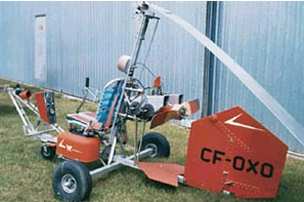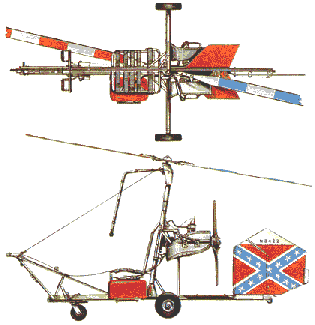
""
BENSEN
AIRCRAFT CORPORATION
|
BENSEN B8-M / X-25 |


|
|
|
A principios de 1950 Igor Bensen, un inmigrante ruso, desarrolló una sorprendente idea de introducir a la gente en la aviación de una manera segura y barata. Su diseño del Gyro-glider y posteriormente el Gyro-copter abrieron un nuevo campo en el mundo de la aviación deportiva. Igor Bensen tomó contacto con los autogiros en la II Guerra Mundial, cuando dirigía el programa de alas rotativas de la General Electric, la cual desarrolló las palas plásticas para el autogiro Kellett XR-3. Al finalizar la guerra, fue uno de los participantes en las pruebas de uno de los modelos del helicóptero Doblehoff WNF 342, que fue capturado por las fuerzas aliadas en Austria. En 1951 se unió a la compañía Kaman Helicopters hasta 1953 donde formó su propia compañía. El primer proyecto de la Bensen Aircraft Corporation fue un helicóptero que contaba con unas hélices en las palas principales para hacer girar el rotor, como el Nagler-Rolz NR 54 V2. La marina canceló este proyecto, designado B-4. Mientras tanto, Bensen comenzó la construcción de un giro remolcado, el "Gyro-glider", similar al Focke-Achgelis FA 330 pero de construcción mas simple. El modelo que ahora nos ocupa, el B-8M, voló por primera vez el 6 de
diciembre de 1955. El set de planos costaba alrededor de 30 dólares o
si uno quería comprar el kit prefabricado debía gastar 995 dólares.
El motor costaba entre los 495 a 1200 dólares. El modelo se podía
construir en unas 40 horas de trabajo. La aeronave tenia una estructura de tubos cuadrados de aluminio con un
rotor de dos palas de madera. El control consistía de una palanca
simple, un acelerador y los pedales para manejar el estabilizador. Al igual que el Gyro-Glider, el Gyro-Copter podía guardarse en el
garage. Para conveniencia del usuario a partir de 1957 entró en
producción una versión automóvil, que podía alcanzar las 35 mph. La
fuerza aérea de los Estados Unidos lo designó como X-25 existiendo
tres modelos diferentes el A, el B y el DDV. El B-8M mas conocido fue el Spirit
of Kitty Hawk, nombrado así debido a que en el 60 aniversario del vuelo
de los hermanos Wright, la aeronave duplicó exactamente el vuelo.
Despegó desde el mismo punto, voló a la misma velocidad y cubrió la
misma distancia que la aeronave de los Wright. VERSIONES Modelo B-8 Super Bug: Versión avanzada del B-8M con dos motores; permitiendo que el rotor gire a mayor velocidad en el despegue, reduciendo la carrera del mismo. Modelo B-8HD: Variante del B-8 Super-Bug, con transmisión hidráulica para accionar el rotor. Modelo B-8W Hydro-Glider: Versión hidroavión del planeador Gyro-Glicer, para ser remolcado por una lancha. Modelo B-8MH Hover-Gyro: Versión avanzada del B-8M, con capacidad para vuelo estacionario, vuelo hacia atrás y hacia los costados. Esta versión constaba de dos rotores coaxiales, uno superior que gira en forma autónoma, y otro en la posición inferior, con motor separado. Modelo B-8V Gyro-Copter: Versión equipada con un motor Volkswagen de automóvil. |
|
|
|
In 1953
Igor Bensen, a Russian immigrant to the United States, realized a
twenty-five-year-old dream—the establishment of his own aircraft
company. Since fleeing to the West during the Russian Revolution, Bensen
had patented thirty-six inventions, had participated in early helicopter
research for the General Electric Company, had organized and directed
the Research Department at Kaman Aircraft Corporation, and had been a
test pilot for both the Air Force and the Navy. His new company was
formed to develop light, safe rotary-wing aircraft for use by private
individuals. The Gyro-Copter. first
flown on December 6. 1955 was a powered version of the Gyro-Glider. It.
too. was designed to be constructed from a set of plans. costng about
$30. or from a prefabricated kit, costing $995. Engines were available
ranging in price from $495 to $1195. As few as forty manhours were
required for kit assembly. The airframe was a
square tubular aluminum structure with a single. two-blade rotor of
laminatec plywood The controls consisted of a single stick with a
twist-grip throttle and toot pedals for the rudder, steering bar and
brakes. As with the Gyro Glider spinning and stalling could not occur
for autorotation would allow the aircraft to settle gently into a normal
landing with no power. Also like the
Gyro-Glider, the Gyro-Copter could be stored in any garage. since it
required a space only 5 ½ 6 x 20 feet. For added convenience. the
Gyro-Copter Model B-8M. put into production in 1957. was roadable. No
equipment had to be changed or removed for the conversion from aircraft
to automobile: the blades were simply locked in the fore-and-aft
position. On the road it Could reach speeds up to 35
mph Several were Successfully driven on highways and through heavy city
traffic during public demonstrations Besides their use as a
pleasure craft Gyro-Copters could be used for terrain and pipeline
aerial surveillance and sport and forestry patrol. In England one was
modified for crop spraying. All three branches of the military had
several in their inventories, and they carried Air Force designation
X-25. The best known of the
Gyro-Copters was the Spirit of
Kitty Hawk, so named because on the sixtieth anniversary of the
Wright brothers historic flight, this aircraft became the first to
duplicate exactly the first powered flight. It took off from the same
spot. flew at the same speed, and covered the same distance as the
Wright aircraft. Some of the
variants are described here. |
|
|
|
|
|
|
Characteristics |
Information |
Characteristics |
Information |
| First
Flight Primer Vuelo |
1955 | Engine Motor |
1
Mc Culloch |
| Seating
Capacity Plazas |
1 |
Power Potencia |
90 HP |
| Empty
Weight Peso Vacío |
247 Lbs |
Hover
Ceiling O.G.E. Estacionario O.G.E |
Ft |
| Maximum
Weight Peso Máximo |
500 Lbs |
Hover
Ceiling I.G.E. Estacionario I.G.E |
Ft |
| Vel.
Cruise Vel. crucero |
40 Kts |
Service
Ceiling Techo de Servicio |
Ft |
| V.N.E. V.N.E |
73 Kts |
Maximum
Range (Std) Alcance (Std) |
87 NM |
Copyright © 1999 / 2003